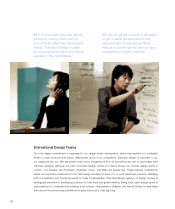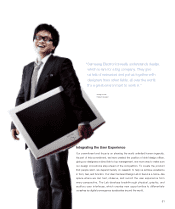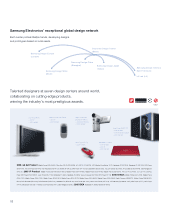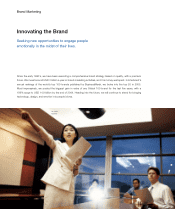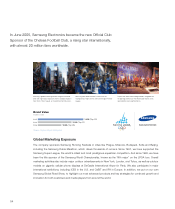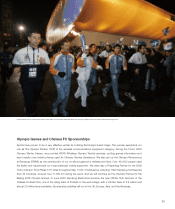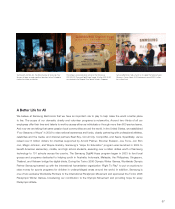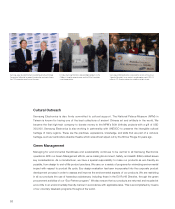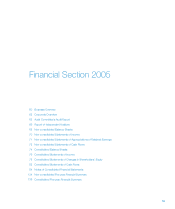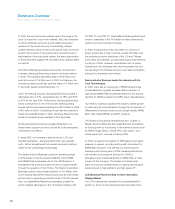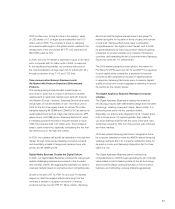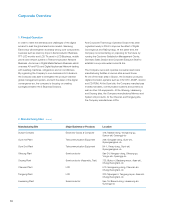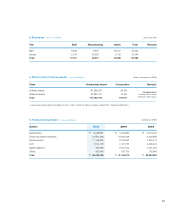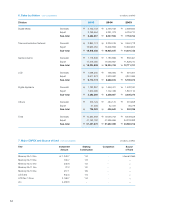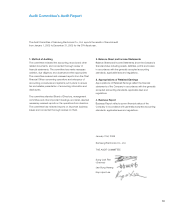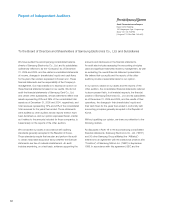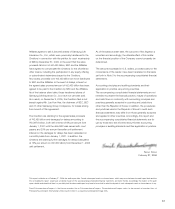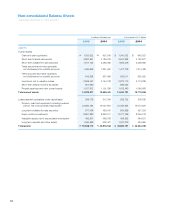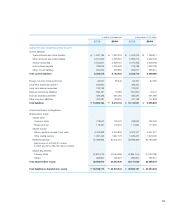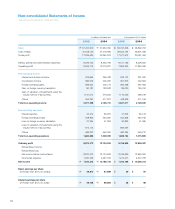Samsung 2005 Annual Report Download - page 62
Download and view the complete annual report
Please find page 62 of the 2005 Samsung annual report below. You can navigate through the pages in the report by either clicking on the pages listed below, or by using the keyword search tool below to find specific information within the annual report.60
In 2005, the world economy suffered due to the surge in the
price of oil and the cost of raw materials. Also, the slowdown
of US and Chinese economic growth added downward
pressure on the world economy. Domestically, despite
positive elements shown in the fourth quarter such as income
growth, improvement in the employment rate and the good
performance of the local stock market, the sharp appreciation
of the Korean Won against the US dollar had a negative affect
on exports.
Amid this challenging business environment domestic and
overseas, Samsung Electronics posted a solid performance
in 2005: The company generated sales of 80.6 trillion won
and net income of 7.6 trillion won in 2005. Furthermore, the
company posted record-high quarterly sales of 15 trillion won
in the fourth quarter ended December 31.
As for the financial structure, Samsung Electronics posted a
debt/asset ratio of 27%, equity/asset ratio of 78%, and ROE
of 21% for the year 2005. Furthermore, Samsung Electronics’
brand continued to be one of the world’s fastest growing
brands with its brand value increasing from $12.6 billion in 2004
to $15 billion in 2005. Considering the fact that the company’s
brand value was $5.2 billion in 2000, Samsung Electronics has
shown an exceptional improvement in its brand value.
All this splendid performance is largely attributed to our
shareholders’ support and trust, as well as to the employees’
commitment and efforts.
In fiscal 2005, our company’s semiconductor, LCD, and
handset businesses - Samsung Electronics’ key business
units - further strengthened their market-dominant positions
based on the cutting-edge technologies.
The Semiconductor Business posted an operating margin
of 30% thanks to the improved profitability of the DRAM
and NAND Flash businesses. As for the LCD Business, it
strengthened its dominant position in the LCD panel market
through the operation of the 7G line. The Telecommunication
Business posted a record-high shipment of 100 million units
by introducing high performing products such as multi-media
phones and by expanding production lines of the 3G phones.
Also, our Digital Media/Appliance businesses posted the
world’s highest sales figure in the TV market including LCD
TV, PDP TV, and CRT TV. This reaffirms Samsung Electronics’
industry leadership in the TV market and also enhances its
position as a world premier company.
In 2006, the global economy may settle into a period of
slower growth due to high oil prices, a weak US dollar, and
the possible economic slowdown of the U.S and Chinese
economies. Domestically, we cautiously expect local demand
to pick up in 2006. However, uncertainties over oil prices,
fluctuations in the exchange rate, and the possible risk of a
hard landing of the Chinese economy may make competition
among the companies more intense.
Semiconductor Business Leads the Industry with Its
Core Technologies.
In 2005, there was an oversupply of DRAM products due
to manufacturers’ capacity increase while production of
high density NAND Flash accelerated thanks to the soaring
demand for NAND products from MP3 player manufacturers.
Our memory business outpaced the industry market growth
by reinforcing its competitiveness through the introduction of
differentiated premium products such as high density NAND
flash, High-Speed DRAM, and MCP products.
The System LSI business maintained its No.1 position in
Display-Driver IC (DDI) and also established the foundations
for future growth by introducing to the market products such
as CMOS image sensor, mobile CPU, chip card IC, and
media player SoC., sources of future profits.
In 2006, we expect the markets for MP3 players and digital
cameras to expand, providing solid growth momentum for
NAND flash products. This will help our Semiconductor
business post a strong year in 2006. Samsung Electronics
will maintain its strong profit structure in 2006 by
strengthening its market leadership in NAND flash, a major
product of the company. The System LSI division also
plans to boost its competitiveness by making technological
advancements in high-definition and high-speed I/F.
LCD Business Paves the Way for Next-Generation
Display Market.
Our LCD business has maintained its uncontestable No.1
position in terms of LCD panel shipments and sales since
Business Overview
From January 1, 2005 to December 31, 2005


